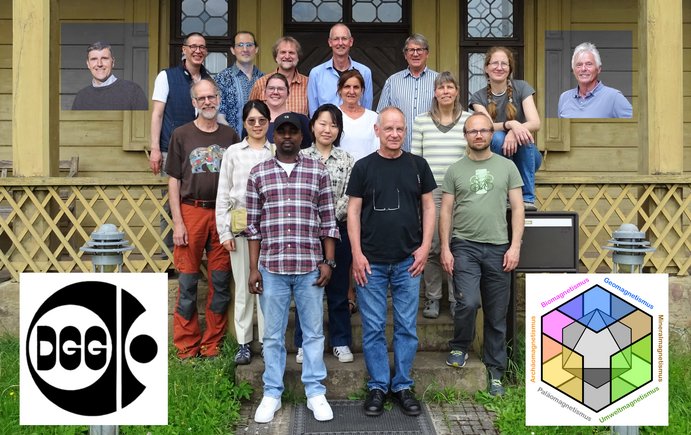At the end of June 2023, a first comprehensive two-day meeting of the new Working Group “Geomagnetics” of the German Geophysical Society (DGG) took place at the palaeomagnetic laboratory of the Leibnitz Institute for Applied Geophysics (LIAG) in Grubenhagen near Hannover. The working group was founded on 30 January 2023 on the initiative of Norbert Nowaczyk, head of the “Laboratory for Earth magnetism in Space and Time” at the GFZ, and now spokesperson of the WG. Its aim is to bundle and further develop the heterogeneously distributed facilities and expertise in the fields of geomagnetic, archaeomagnetic, palaeomagnetic, mineralmagnetic, environmental magnetic and biomagnetic research in Germany and neighbouring countries.
The participants discussed current and future developments, such as the importance of palaeomagnetic laboratories for the entire geoscientific community. Furthermore, possible joint projects were discussed in order to use synergy effects within the diverse application areas of geomagnetic research.
The AK Geomagnetics is open to all interested colleagues and will also successively expand its networking activities in Europe and internationally.
An overview about the broad spectrum of geomagnetic research topics
Geomagnetism
Geomagnetism deals with the observation and measurement of the present-day Earth's magnetic field, both from the ground, by means of geomagnetic observatories, and in space by satellites. The data obtained are used in a variety of ways: to calculate the International Geomagnetic Reference Field (IGRF), to map magnetic anomalies in the Earth's crust, to characterise particle current systems and conditions in near-Earth space (Space Weather), and to analyse the electrical conductivity of the entire Earth's mantle and the dynamics of the Earth's outer core. Relevant research areas also include global reconstructions of variations, polarity reversals and intensity fluctuations of the Earth's magnetic field, incorporating palaeomagnetic data (see below) reaching far back into the geological past.
Archaeo- and palaeomagnetism
Data for studying the properties and changes of the geomagnetic field before the time of direct measurements are obtained from anthropogenic artefacts (archaeomagnetism) and rocks (palaeomagnetism) in laboratory experiments. In addition to insights into magnetic field variations, these data are also used for dating archaeological materials as well as for magnetostratigraphic dating of sedimentary and volcanic sequences, characterising magmatic processes and plate tectonic reconstruction. Current questions on the origin of the solar system and planetary dynamos are also addressed by applying palaeomagnetic methods to meteorites.
Mineral magnetism and environmental magnetism
Mineral magnetism deals with the investigation of archaeo- and palaeomagnetic archives with regard to the content of magnetic minerals and their composition, grain size and genesis as well as their state of preservation. The results serve not only to verify the documented magnetic field variations, but also to reconstruct environmental conditions at the time of the archives' formation (environmental magnetism). In addition, magnetic mapping and soil analyses are used to detect and analyse the anthropogenic input of magnetic particles into the environment through industry or traffic.
Biomagnetism
Living organisms, such as magnetotactic bacteria, also synthesise magnetic particles and interact with the Earth's magnetic field – this is the field of biomagnetism. As a source of magnetic minerals, iron-reducing and -oxidising bacteria play an important role in the global iron cycle. They provide valuable information about primary production as well as exchange in lakes, river deltas and oceans. Biogenically produced magnetic particles also contribute to the record of geomagnetic field variations in sediments. In combination with determinations of the content of cosmogenic radionuclides and geochemical investigations, insights into climate history can be gained. This supports efforts to understand current climate changes.
Applications of the methods in other disciplines
The methodologies covered by AK Geomagnetics also have overlaps with other scientific and applied disciplines, such as biology, medicine, solid-state physics, prehistory and early history, environmental engineering, ordnance detection and nautical science.




